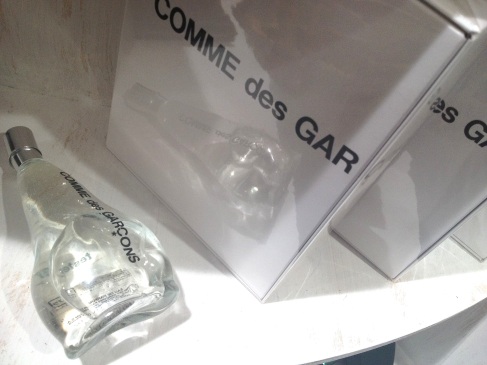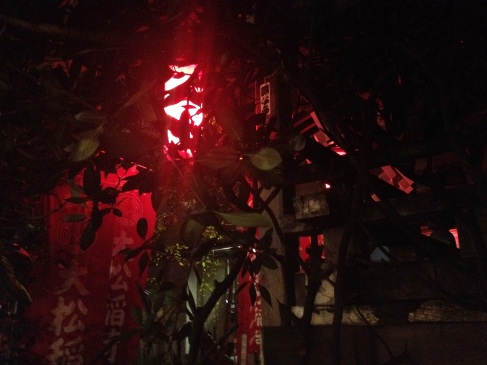“A flower that couldn’t exist, in a bottle that shouldn’t exist….”

It was a cold, clear day on Monday when I headed out to Tokyo to buy Kyoto. Junko and I have a tradition now of exchanging presents each year – I buy her a perfume, she gets me films – and though last year’s offering, the exotic and pungent Powder Flowers by Montale, had gone down quite well, I decided to try something different this time and go for incense, something more contemplative and grounded. I love the challenge of trying to instinctively nose out what someone might like, to edge closer and closer towards their holy grail, and this time my inklings turned out to be right.
She loved it. We met last night at a bar in Fujisawa, where I presented birthday present 2012, and the look on her face as she kept on smelling it incessantly from her wrist was precious: she had obviously never smelled anything like this (at least not bottled). The cypress, cedar, teak wood, incense and patchouli scent was a very new departure for her fragrance-wise, and one that obviously hit the mark (‘think of it as the hinoki-avenued walk up to Toshogu temple in Nikko’ I said), and she seemed simultaneously emotionally enraptured and turned-on by the smouldering, auto-erotically charged smells of timber and spice emanating from her skin. It certainly suits her, especially sprayed onto the cuffs of her biker jacket.
The perverse thing is that I don’t really like ‘Kyoto’ myself. I love the city the perfume is named after, but personally don’t relate to its dry, simplistic olfactory rendering in Bertrand Duchaufour’s re-creation. To me it is just a typical, unmysterious blend of flat, modish, contemporary WOODs (direct, obvious) with no beauty or space between the rings of bark. It is well made, yes, and effective as a basic beginner incense scent – but at most 10% successful in capturing the deeply austere spirituality of the real place, which is steeped in the indescribable.
No. Instead, take one incense stick from its paper box, purchased from the centuries old Kyukodo or Shoyeido incense emporia in the heart of the city, and light it in the entrance of your home. Soft smoke, exquisitely tendered and balanced – aloeswood, sandalwood, cloves, camphor, rose – will rise, gradually, into the air, slowly changing your consciousness. This is Kyoto.


I had taken the Shonan-Shinjuku line from Kamakura, getting off at Shibuya station around rush hour (not recommended for the claustrophobic or agoraphobic), changed to the Yamanote and walked up from Harajuku station, down the twinkling illuminated boulevard of Omotesando, and then up to Aoyama, where the Comme Des Garcons boutique nestles between a little temple and gleaming, futuristic architecture. While the requisitely hypertrended assistants fastidiously wrapped up my Kyoto I sampled and resampled the main CDG line, which is housed in one of many nooks of a giant white tardis.






It was here that I came across a perfume I had somehow overlooked: the fascinating ‘Eau de Parfum’, a self-oxidising flower exhaling its last breaths somewhere in the stratosphere circa 2064. Given that the first CDG perfume, the one that launched Rei Kawakubo’s avant-garde perfumery into our consciousness (one of the spiciest clove scents ever made) is also called Eau de Parfum, it seemed strange that they would want us to confuse the two scents (which are completely different), by giving them the same title. Nevertheless, there it lay, ruined in its tortured, self-imploded bottle that can’t even stand up, on one of the lower shelves, almost out of sight. Having no idea what to expect, I sprayed a couple of cards with copious amounts and to my surprise found that I liked it, though in theory I shouldn’t.
Comme Des Garcons is well know for its twisting and subverting of what is considered beautiful (or acceptable) in fragrance with wilfully abstruse concepts such as those found in the Synthetic Series and the industrialized abstractions of Odeur 53: (notes of ‘flaming rock; nail polish; fire energy; washing drying in the wind; sand dunes; burnt rubber, the freshness of oxygen and pure air of the high mountains’); and Odeur 71 (xerox machine; washing fresh from the dryer; lettuce juice; electricity, dust on a hot lightbulb….)
I delight in the fact that such border-pushing exists in perfumery. And I don’t particularly mind if the person sitting next to me in the office smells of a pulsating photo-copier, an eraser, or a lightly-dusted lightbulb, but on me, on my own human skin, these mutated ozones and man-made chemical novelties simply make me feel sick. I would never.
Eau de Parfum is different. Here the human, the natural, and synthetic are fused in a blinding medley of white; a futuristic flower in bondage, wrapped in glue and masking tape and sputnicked-off into ether. And it is strangely beautiful. Where with the Odeurs I have always found that the notes elbow and jostle with each other to outdo each other in weirdness (‘look, there’s an incinerated paper clip!), in Eau de Parfum they glide together, amassing whiteness; the more conventional hawthorn/lilac aromas a solidly pretty foundation upon which to layer the swathes of safraleine (a synthetic that mimicks the scent of saffron and suede simultaneously), ‘flower oxides’ and circumscribing it all, the familiarly toxic smell of freshly opened glue and packing tape.
The ‘flower in bondage’ idea has done before in Serge Lutens’ underrated Nuit de Cellophane, but that perfume was more a fetishized pneumatic tuberose/osmanthus babe à la Helmut Newton, wrapped in cling-film and emerging from her little Berlin S+ M photography session to a glass or two of champagne (and whatever else) with the fetishistic maestro of kink. Aside an acrylic top note like the cellophane that wraps a bouquet of midnight yellow roses, Serge Lutens’ creation was surprisingly conventional.
The Comme Des Garcons is different, more ferociously futurist. But although Eau de Parfum can shock with its plasticity, as with Cellophane, the natural components in the blend, such as the vanillic resin styrax lurking down in the base, do steady these tender flowers and make them relatable, as do the gentle laundry musks that while equally synthetic, we have come to equate with clean humanity.
Like the gleaming unperturbable blanc of the Comme Des Garcons store’s permaglass surfaces, Eau de Parfum is an essay in white. A space-age lilac; its flower narcotized by the safraleine, as though these sussurating flowers, with gentle May hawthorn for company, were sent off into outerspace – lain down on suede and nudged into polystrene – while equipment, pristine from the production line, awaits in boxes; adhesive-sealed and bubble-wrapped. The note of baby powder that lies like a memory within the liquid is like the gargantuan foetus suspended in its galactic amniotic sac in Kubrick’s 2001, a memory of something tender several centuries before….


Still in a trance from these science fictional musings I unthinkingly reached for another perfume in another outrageous bottle: Luxe: Patchouli, which I knew I didn’t like (on paper) but which I thought I would give another chance (a big, unctuously drippy spray) on the back of my hand. Oh Lord I wish I hadn’t. If any perfume could make me puke it is this. And nowhere to wash it off…..
Any regular readers of The Black Narcissus will know that I am a big patchouli wearer, but this is only nominally a member of that illustriously earthy family that I love so much. No: this is is a troll. A foul, tepidly warm bowl of celery cream soup, steeped and fermenting in fenugreek, curry, lovage and simmering leaves of Javan patchouli.
I HATE this. Celery is one of my favourite foods, but this celeriac, salted celery-seed note in such a thick, creamy alliance (opoponax, vanilla, oak) gives me a powerful, nauseated, punch in the bowels.
I do try and remain objective as far as possible when reviewing perfumes, and the dry down (six hours later, when I woke up in the middle of the night, sweating) has that warm, aromatic edginess that would go well on a studied, Comme Des Garcons freak. I mean this unfacetiously. The brand truly ‘pushes the envelope’ in fashion, and this perfume could match certain of the bizarre, origamied ensembles perfectly. It is original, I will give it that. But I honestly think that if for some reason I were forced to wear this monstrosity on a daily basis, I would contemplate suicide.

Better, if need be, to wear Eau de Parfum, much as it would eventually pain me to constantly be in its clinical embrace. To be wrapped in acrylics; suffocated in industrial chemicals and leather, and sent out, supine, embalmed in lilac, into the forever…


















































